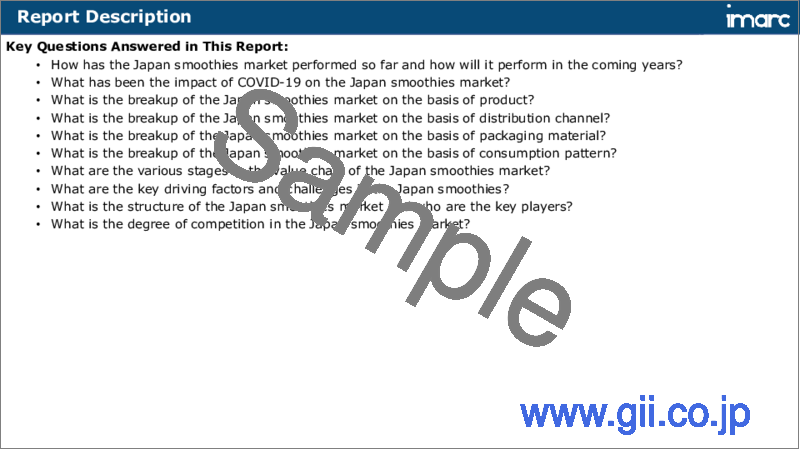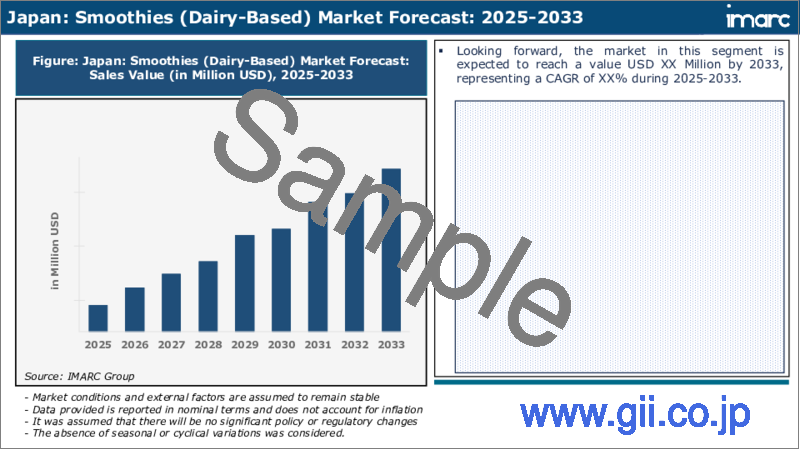|
|
市場調査レポート
商品コード
1746883
日本のスムージー市場レポート:製品別、流通チャネル別、包装材料別、消費パターン別、地域別、2025年~2033年Japan Smoothies Market Report by Product, Distribution Channel, Packaging Material, Consumption Pattern, and Region 2025-2033 |
||||||
カスタマイズ可能
|
|||||||
| 日本のスムージー市場レポート:製品別、流通チャネル別、包装材料別、消費パターン別、地域別、2025年~2033年 |
|
出版日: 2025年06月02日
発行: IMARC
ページ情報: 英文 122 Pages
納期: 5~7営業日
|
全表示
- 概要
- 目次
日本のスムージー市場規模は2024年に10億米ドルに達しました。今後、IMARC Groupは、2033年までに市場は20億米ドルに達し、2025年から2033年にかけて7.6%の成長率(CAGR)を示すと予測しています。植物ベースの食生活やベジタリアン/ビーガンライフスタイルの人気の高まりが、アーモンドミルク、豆乳、オートミルクのような植物ベースの代替ミルクで作られたスムージーの需要を高め、市場を牽引しています。
本レポートで扱う主な質問
- 日本のスムージー市場はこれまでどのように推移し、今後どのように推移するのか?
- COVID-19が日本のスムージー市場に与えた影響は?
- 日本のスムージー市場の製品別区分は?
- 日本のスムージー市場の流通チャネル別区分は?
- 日本のスムージー市場の包装材料別の区分は?
- 日本のスムージー市場の消費パターン別内訳は?
- 日本のスムージー市場のバリューチェーンにおける様々なステージとは?
- 日本のスムージー市場の主要な促進要因と課題は何か?
- 日本のスムージー市場の構造と主要プレーヤーは?
- 日本のスムージー市場における競合の程度は?
目次
第1章 序文
第2章 調査範囲と調査手法
- 調査の目的
- ステークホルダー
- データソース
- 市場推定
- 調査手法
第3章 エグゼクティブサマリー
第4章 日本のスムージー市場- イントロダクション
- 概要
- 市場力学
- 業界動向
- 競合情報
第5章 日本のスムージー市場情勢
- 過去および現在の市場動向(2019~2024年)
- 市場予測(2025~2033年)
第6章 日本のスムージー市場- 製品別の内訳
- 乳製品ベース
- フルーツベース
第7章 日本のスムージー市場- 流通チャネル別の内訳
- レストランとスムージーバー
- スーパーマーケットとハイパーマーケット
- コンビニエンスストア
- その他
第8章 日本のスムージー市場- 包装材料別の内訳
- プラスチック
- 紙
- ガラス
- その他
第9章 日本のスムージー市場- 消費パターン別の内訳
- 屋外広告
- 家庭
第10章 日本のスムージー市場- 競合情勢
- 概要
- 市場構造
- 市場企業のポジショニング
- 主要成功戦略
- 競合ダッシュボード
- 企業評価象限
第11章 主要企業のプロファイル
第12章 日本のスムージー市場- 業界分析
- 促進要因・抑制要因・機会
- ポーターのファイブフォース分析
- バリューチェーン分析
第13章 付録
Japan smoothies market size reached USD 1.0 Billion in 2024. Looking forward, IMARC Group expects the market to reach USD 2.0 Billion by 2033, exhibiting a growth rate (CAGR) of 7.6% during 2025-2033. The increasing popularity of plant-based diets and vegetarian/vegan lifestyles, which has enhanced the demand for smoothies made with plant-based milk alternatives like almond, soy, and oat milk, is driving the market.
Smoothies are delicious and nutritious beverages made by blending various ingredients into a thick, creamy consistency. They typically consist of a base liquid, such as water, milk, yogurt, or fruit juice, combined with fruits, vegetables, and other flavor-enhancing ingredients. The versatility of smoothies allows for endless combinations, making them a popular choice for breakfast, snacks, or post-workout refueling. They offer a convenient way to incorporate a wide range of nutrients into a diet, including vitamins, minerals, fiber, and antioxidants. One of the key benefits of smoothies is their potential to boost overall health. They can aid in weight management, support digestion, and provide a quick energy boost. Additionally, smoothies are an excellent way to sneak in servings of fruits and vegetables, which can be especially appealing for picky eaters. Whether it is a classic fruit smoothie, a green smoothie packed with leafy greens, or a protein-packed version with ingredients like peanut butter or protein powder, smoothies offer a tasty and convenient way to nourish the body.
Japan Smoothies Market Trends:
The smoothie market in Japan has experienced remarkable growth in recent years due to several key drivers. Firstly, the growing emphasis on health and wellness has fueled consumer demand for nutritious food options. Consequently, people are turning to smoothies as a convenient way to incorporate fruits, vegetables, and other wholesome ingredients into their diets. Additionally, the rise of fitness culture and the desire for post-workout recovery options have contributed to the surge in smoothie consumption. Moreover, the increased awareness of dietary restrictions and preferences, such as veganism and lactose intolerance, has driven the development of dairy-free and plant-based smoothie alternatives. As a result, the market has diversified to cater to a wider range of dietary needs and preferences. Furthermore, the convenience factor plays a significant role, as busy lifestyles have led to a growing demand for on-the-go meal replacements. Hence, the portability and quick preparation of smoothies make them an attractive choice for modern consumers. In conclusion, the smoothie market in Japan continues to thrive due to health consciousness, fitness trends, dietary preferences, and the convenience they offer, making it a dynamic and evolving industry with a promising future.
Japan Smoothies Market Segmentation:
Product Insights:
- Dairy-Based
- Fruit-Based
Distribution Channel Insights:
- Restaurants and Smoothie Bars
- Supermarkets and Hypermarkets
- Convenience Stores
- Others
Packaging Material Insights:
- Plastic
- Paper
- Glass
- Others
Consumption Pattern Insights:
- Out of Home
- At Home
Competitive Landscape:
The market research report has also provided a comprehensive analysis of the competitive landscape. Competitive analysis such as market structure, key player positioning, top winning strategies, competitive dashboard, and company evaluation quadrant has been covered in the report. Also, detailed profiles of all major companies have been provided.
Key Questions Answered in This Report:
- How has the Japan smoothies market performed so far and how will it perform in the coming years?
- What has been the impact of COVID-19 on the Japan smoothies market?
- What is the breakup of the Japan smoothies market on the basis of product?
- What is the breakup of the Japan smoothies market on the basis of distribution channel?
- What is the breakup of the Japan smoothies market on the basis of packaging material?
- What is the breakup of the Japan smoothies market on the basis of consumption pattern?
- What are the various stages in the value chain of the Japan smoothies market?
- What are the key driving factors and challenges in the Japan smoothies?
- What is the structure of the Japan smoothies market and who are the key players?
- What is the degree of competition in the Japan smoothies market?
Table of Contents
1 Preface
2 Scope and Methodology
- 2.1 Objectives of the Study
- 2.2 Stakeholders
- 2.3 Data Sources
- 2.3.1 Primary Sources
- 2.3.2 Secondary Sources
- 2.4 Market Estimation
- 2.4.1 Bottom-Up Approach
- 2.4.2 Top-Down Approach
- 2.5 Forecasting Methodology
3 Executive Summary
4 Japan Smoothies Market - Introduction
- 4.1 Overview
- 4.2 Market Dynamics
- 4.3 Industry Trends
- 4.4 Competitive Intelligence
5 Japan Smoothies Market Landscape
- 5.1 Historical and Current Market Trends (2019-2024)
- 5.2 Market Forecast (2025-2033)
6 Japan Smoothies Market - Breakup by Product
- 6.1 Dairy-Based
- 6.1.1 Overview
- 6.1.2 Historical and Current Market Trends (2019-2024)
- 6.1.3 Market Forecast (2025-2033)
- 6.2 Fruit-Based
- 6.2.1 Overview
- 6.2.2 Historical and Current Market Trends (2019-2024)
- 6.2.3 Market Forecast (2025-2033)
7 Japan Smoothies Market - Breakup by Distribution Channel
- 7.1 Restaurants and Smoothie Bars
- 7.1.1 Overview
- 7.1.2 Historical and Current Market Trends (2019-2024)
- 7.1.3 Market Forecast (2025-2033)
- 7.2 Supermarkets and Hypermarkets
- 7.2.1 Overview
- 7.2.2 Historical and Current Market Trends (2019-2024)
- 7.2.3 Market Forecast (2025-2033)
- 7.3 Convenience Stores
- 7.3.1 Overview
- 7.3.2 Historical and Current Market Trends (2019-2024)
- 7.3.3 Market Forecast (2025-2033)
- 7.4 Others
- 7.4.1 Historical and Current Market Trends (2019-2024)
- 7.4.2 Market Forecast (2025-2033)
8 Japan Smoothies Market - Breakup by Packaging Material
- 8.1 Plastic
- 8.1.1 Overview
- 8.1.2 Historical and Current Market Trends (2019-2024)
- 8.1.3 Market Forecast (2025-2033)
- 8.2 Paper
- 8.2.1 Overview
- 8.2.2 Historical and Current Market Trends (2019-2024)
- 8.2.3 Market Forecast (2025-2033)
- 8.3 Glass
- 8.3.1 Overview
- 8.3.2 Historical and Current Market Trends (2019-2024)
- 8.3.3 Market Forecast (2025-2033)
- 8.2 Others
- 8.4.1 Historical and Current Market Trends (2019-2024)
- 8.4.2 Market Forecast (2025-2033)
9 Japan Smoothies Market - Breakup by Consumption Pattern
- 9.1 Out of Home
- 9.1.1 Overview
- 9.1.2 Historical and Current Market Trends (2019-2024)
- 9.1.3 Market Forecast (2025-2033)
- 9.2 At Home
- 9.2.1 Overview
- 9.2.2 Historical and Current Market Trends (2019-2024)
- 9.2.3 Market Forecast (2025-2033)
10 Japan Smoothies Market - Competitive Landscape
- 10.1 Overview
- 10.2 Market Structure
- 10.3 Market Player Positioning
- 10.4 Top Winning Strategies
- 10.5 Competitive Dashboard
- 10.6 Company Evaluation Quadrant
11 Profiles of Key Players
- 11.1 Company A
- 11.1.1 Business Overview
- 11.1.2 Product Portfolio
- 11.1.3 Business Strategies
- 11.1.4 SWOT Analysis
- 11.1.5 Major News and Events
- 11.2 Company B
- 11.2.1 Business Overview
- 11.2.2 Product Portfolio
- 11.2.3 Business Strategies
- 11.2.4 SWOT Analysis
- 11.2.5 Major News and Events
- 11.3 Company C
- 11.3.1 Business Overview
- 11.3.2 Product Portfolio
- 11.3.3 Business Strategies
- 11.3.4 SWOT Analysis
- 11.3.5 Major News and Events
- 11.4 Company D
- 11.4.1 Business Overview
- 11.4.2 Product Portfolio
- 11.4.3 Business Strategies
- 11.4.4 SWOT Analysis
- 11.4.5 Major News and Events
- 11.5 Company E
- 11.5.1 Business Overview
- 11.5.2 Product Portfolio
- 11.5.3 Business Strategies
- 11.5.4 SWOT Analysis
- 11.5.5 Major News and Events
12 Japan Smoothies Market - Industry Analysis
- 12.1 Drivers, Restraints, and Opportunities
- 12.1.1 Overview
- 12.1.2 Drivers
- 12.1.3 Restraints
- 12.1.4 Opportunities
- 12.2 Porters Five Forces Analysis
- 12.2.1 Overview
- 12.2.2 Bargaining Power of Buyers
- 12.2.3 Bargaining Power of Suppliers
- 12.2.4 Degree of Competition
- 12.2.5 Threat of New Entrants
- 12.2.6 Threat of Substitutes
- 12.3 Value Chain Analysis






